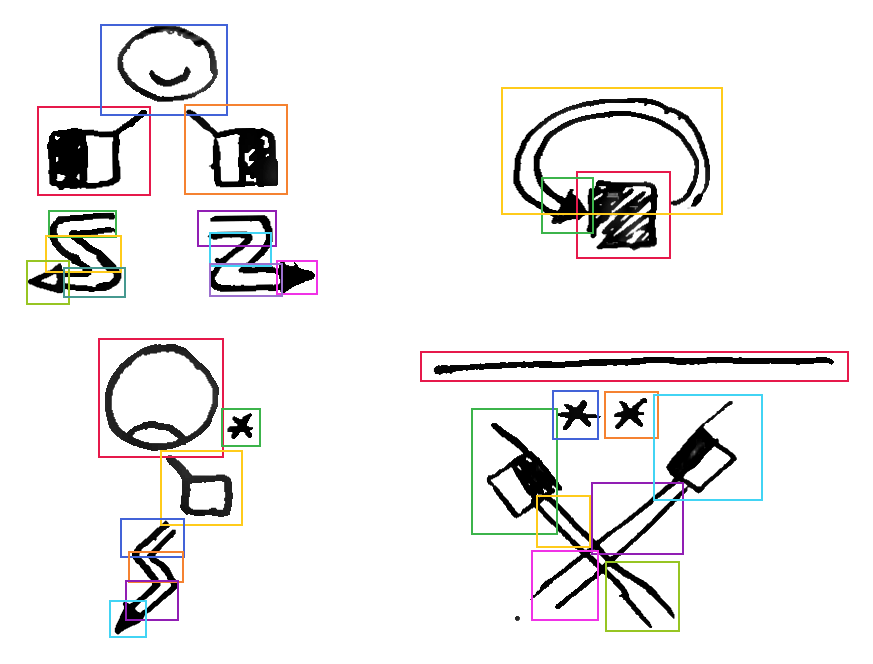7.4 Movements
Hand movements are an integral part of sign language, and therefore a substantial part of SignWriting. They are codified with paths and arrows that iconically depict the 3-D movements of the hands in the page. To properly encode 3-D space in 2-D writing, they use graphical attributes to distinguish between planes of movement.
| | | | | | | | | |
| | | | | | | | | |
In the digital typographies of SignWriting, there are tens of thousands of characters to account for a wide variety of possible trajectories and types of movement. When devising an annotation schema for movement, and especially when dealing with handwritten SignWriting, using a flat classification is unpractical.
Therefore, in this corpus, movements are annotated by decomposing
them into segments, and annotating the segments. These segments convey
either straight (STEM) or curved (ARC)
paths, and end of movement markers or “arrow heads”
(ARRO). Additionally, since the shoulders and waistline
are depicted in SignWriting with straight lines, they are
provisionally annotated as STEM. The forearm shares many
characteristics of STEMs, so it too is annotated as
such.

Movement segments have directional information, annotated in their
ROT tag, and plane distinctions, annotated in the
SHAPE tag. Arrow heads have directional information as
well, annotated in the ROT tag, but the
SHAPE tag is used to annotate the type of arrow head,
which is used in SignWriting to denote what hands move along each
path.
Segments often overlap, depicting for example crossing movements of
the hands, or a curved segment can be superposed over a straight
segment to convey rotation simultaneous to displacement. If these
segments have different CLASSes, their bounding boxes are
annotated as usual. If the CLASS is the same, the overlap
in bounding boxes can make them meaningless. This is very common with
crossed forearms configurations, or with X-shaped
movements. In these cases, straight segments are subdivided, and each
division annotated independently, as in Figure
7.2.
7.4.1 ARRO
Arrow heads mark which hand moves, encoded in their
SHAPE tag. They can be black (right hand),
white (left hand) or j, for both hands
joining in the movement. They also point in a cardinal direction,
annotated in their ROT tag.
b |
| w |
| j |
|
N |
| NE |
| E |
| SE |
|
NW |
| W |
| SW |
| S |
|
7.4.2 STEM
Straight lines can represent the shoulders or waistline, straight
movements, the forearm, or both the forearm and a movement at the same
time. Their direction is marked in the ROT tag using
cardinal directions. Since they are symmetric, only half of the
possible ROT values are used.
To distinguish between vertical and horizontal movements or
forearms, STEMs can be single or double, which is
annotated in the SHAPE tag. Shoulders and waists are
always single.
s |
| d |
|
N |
| NE |
| E |
| SE |
|
7.4.3 ARC
Curved paths represent arcing or circular movements.
As in STEMs, single and
double paths represent horizontal and vertical planes of
movement. This is encoded with the first letter of the
SHAPE tag. The second letter is used to determine the
amplitude of the movement, and can take three values: q
for ‘quarter’, a small arc; h for ‘half’, a bigger arc
which covers around half a circle, and f for ‘full’ for
fully circular paths. Distinction between q and
h can be difficult without underlying understanding of
the sign language depicted, but with some practice it becomes more
intuitive.
To determine the ROTation of ARCs, two
points need to be mentally found. The first one is the center of the
circle on which the ARC lies. The second one is the
middle point of the ARC segment. ‘Fully’ circular
ARCs still have a middle points, since they start and end
at the arrow head. Once these two points are determined, the cardinal
direction to annotate for the ROT is the direction in
which points the segment from the center to the middle point. Table 7.14
will probably make this clearer.
sq |
| sh |
| sf |
|
dq |
| dh |
| df |
|
N |
| NE |
| E |
| SE |
|
NW |
| W |
| SW |
| S |
|